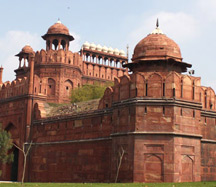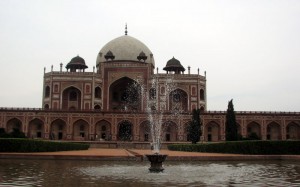Visit Red Fort; Built by Shah Jahan, the most prolific architect and builder of the Mughal Empire, It was the seat of Mughal power
from 1639 to 1857. Designed by the Mughal architects Ustad Hamid and Ahmad, Red Fort is an important symbolic monument in India even today. Some of the captivating building it encloses is Diwaniam, DiwaniKhas, Rang Mahal, The Pearl Mosque etc.
Jama Masjid; the last work of Emperor Shah Jahan. Its construction began in 1650 and was completed within six years. You can relive the Mughal or Mogul history of Delhi passing through the splendid corridors of this ancient mosque. The Jama Masjid stands across the road in front of the Red Fort.
Rashtrapati Bhavan; It is the official residence of the President of India. The Rashtrapati Bhawan stands out as an architectural marvel that overlooks the lush green lawns around India Gate. It has a magnificent view of the Rajpath and symmetrical North and South block government offices.
India Gate; India Gate was designed by Sir Edwin Lutyens. Originally known as All India War Memorial, it commemorates the 90,000 soldiers of the British Indian Army who lost their lives during World War I. Burning in a shrine under the arch of India Gate since 1971 is the Amar Jawan Jyoti or the eternal flame which symbolizes the sacrifice of brave Indian soldiers.
Humayun’s Tomb; Humayun’s tomb is the tomb of the Mughal Emperor Humayun. The tomb was commissioned by Humayun’s wife Hamida Banu Begum in 1562 AD, and designed by Mirak Mirza Ghiyath, a Persian architect. It was the first garden-tomb on the Indian subcontinent, and is located in Nizamuddin East, Delhi, India, close to the Dina-panah citadel also known as Purana Qila (Old Fort), that Humayun founded in 1533. It was also the first structure to use red sandstone at such a scale. The tomb was declared a
UNESCO World Heritage Site in 1993, and since then has undergone extensive restoration work, which is still underway. Besides the main tomb enclosure of Humayun, several smaller monuments dot the pathway leading up to it, from the main entrance in the West, including one that even pre-dates the main tomb itself, by twenty years; it is the tomb complex of Isa Khan Niyazi, an Afghan noble in Sher Shah Suri’s court of the Suri dynasty, who fought against the Mughals, constructed in 1547 CE
Qutub Minar; inspired by the Minaret of Jam in Afghanistan and wishing to surpass it, Qutbuddin Aibak, commencedconstruction of the Qutub Minar in 1193, but could only complete its base. Later, his successors, added other stories. The development of various architectural styles from Aibak to Tughluq is quite evident in the minaret. Numerous inscriptions in Arabic and Nagari characters in different places of the Minar reveal the history of Qutub. Qutub Minar, the lofty tower is a heritage site which showcases the rich Mughal or Mogul past of India. The minaret is 234 feet high making it one of the highest individual towers in the world.


